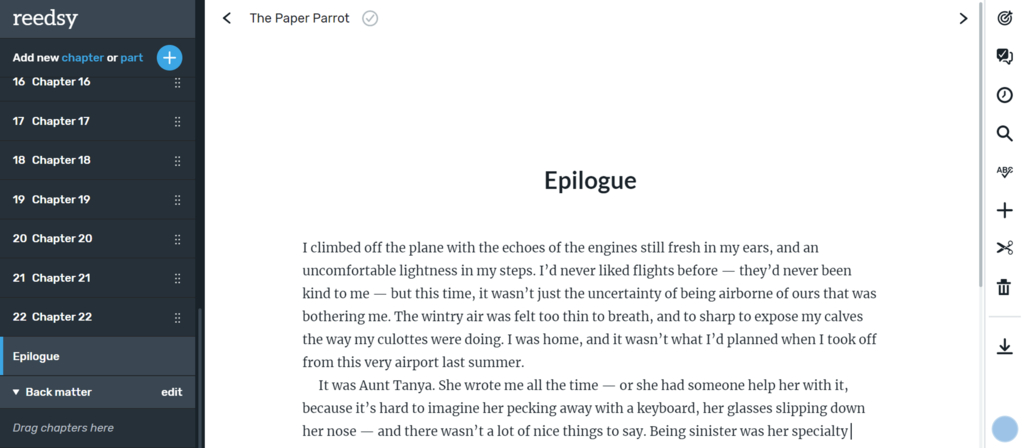Guides • Perfecting your Craft
Last updated on Oct 15, 2025
What is the Epilogue of a Book? Just One More Thing…
Martin Cavannagh
Head of Content at Reedsy, Martin has spent over eight years helping writers turn their ambitions into reality. As a voice in the indie publishing space, he has written for a number of outlets and spoken at conferences, including the 2024 Writers Summit at the London Book Fair.
View profile →In a book, the epilogue is the section of writing at the end that takes place after the main narrative is over. It often offers a glimpse into the future, showing what happes after the primary conflict has been resolved or answering any lingering questions and character arcs. The purpose of an epilogue is to provide clarity, emotional closure, or even set up a sequel.
But if you write a strong ending to a story, should there really be anything left to say? Well, like a good digestif, an epilogue can serve as a satisfying close to a story — one that gives you a moment to reflect on everything you just consumed. It shouldn’t replace the novel's ending but merely provide a grace note for the story to close on.
In this article, we’ll reveal everything you need to know about epilogues, including examples and tips for writing them, courtesy of some of Reedsy’s top editors. But first, let’s kick things off with a crucial distinction...
An epilogue is often mistaken for an afterword
Epilogues and afterwords are commonly confused — likely on account of how they both appear at the end of a book’s body. But the two terms are not interchangeable. The epilogue of a book ties up loose ends that require resolving and could not be tidied up within the main part of the narrative. It’s a part of the larger story.
On the other hand, an afterword addresses how the book came to be, the inspiration for the story, the journey of its development, etc. Sometimes it’s written by the author, and sometimes it’s written by a public figure with some connection to the story or subject matter, but it’s never part of the story itself.
Tip: Make sure your book actually benefits from an epilogue
Not all stories need an epilogue, and there is often much to be gained by ending on a high or leaving the ending open to the reader’s imagination. Make sure you aren’t using your epilogue to beat a dead horse, or as a band-aid to patch up holes in your story. It's better to focus on ending the main body of your story on a strong note, than to try and compensate for a weak ending with an epilogue.
An epilogue in a book should always be an added bonus, not a necessary ingredient. The denouement of the main narrative should be strong enough to tie the story together on its own, without the extra embellishment. Just think of the word epilogue itself to remember this point, advises Oxford University Press editor Hannah Hirst-Dunton:
“The prefix 'epi-' means 'added' or 'next to' — when labelling text as an epilogue, you should definitely bear that in mind!”
The great part about an epilogue coming at the end is that it's easy to add onto your story — and remove, should you decide you need to. Using a writing app like Reedsy Studio allows you to automatically place your epilogue in the right place, edit it, or even cut it out entirely, while also saving everything you write just in case you change your mind.

It provides the reader with a cathartic release
The epilogue of a book might allude to what happens after the story’s end, which can be particularly satisfying if the lead-up has been full of suspense — like editor Lourdes Venard puts it: “if the characters have faced dangers or an upheaval to their life.” This doesn’t mean you have to wrap the story up with a Happily-Ever-After bow — just give the reader a chance to let go of the breath they’d been holding during your high-stakes finale.
In this sense, an epilogue provides a glimpse of the world and the book's characters once the dust has settled. Such an epilogue doesn’t have to give answers and even much in terms of clarity, but it can end the story with a powerful suggestion of the continued existence of this fictional world.
Example: Moby-Dick by Herman Melville
The chaotic end of Moby-Dick involves the long-awaited encounter of Captain Ahab and the whale, and the sinking of a ship to boot! In the epilogue, Ishmael (our narrator and a sailor on said ship) survives by floating on a coffin. He reminds us that it is this providential yet ironic buoy that has allowed him to recount the epic tale of man vs. nature we’ve been reading all along.
Tip: Keep your epilogues short and sweet
By the time readers come to the end of your novel, they should feel satisfied, and ready to reflect on what they’ve just read. What they usually don’t want is to think they’ve reached the end, only to be met with pages and pages of epilogue. Keep your epilogue short, and to the point — ideally an epilogue should be no more than the length of a short chapter, around 5-8 pages.
In other words, as editor Allister Thompson puts it:
“If there’s nothing else to say, don’t be tempted to say it!”
Remember, the main plot has been resolved before the epilogue, so you only want to dole out information to add further depth. You could go on explaining exactly where all of your characters are 10 years into the future, but if this doesn’t contribute to the reader’s understanding of the story, characters, or their world — leave it be.
The best sense a writer can give a reader at the end of a book is that the story lives on — that the characters and their lives are so rich, you can’t help but imagine what paths they take after the last page is finished. Tacking an info-dumping epilogue onto an already substantial ending can set your readers up for an anticlimactic letdown, so don’t use an epilogue to tie a knot on every single thread of your story; leave a few loose so that we can come back to them and continue to imagine where they lead later. Ask yourself how the information in the epilogue ties into your story and themes and cut away the excess.
They’re an opportunity to resolve character arcs
Classic Greek and Elizabethan plays often include epilogues to explain the fates of the characters. An actor would step forward and speak directly to the audience, offering commentary on the story and dispensing morals, if any were found in the tale. This still remains a popular literary device for authors, though it’s no longer a direct commentary.
Ideally, readers will grow invested in the characters that you’ve so carefully created — and if they do, they’ll want to know that the characters are okay in the end. Even if they’re not okay, enthusiastic readers still want to understand the characters’ fate within the story's scope.
Epilogues often do this by providing a glimpse into the characters’ lives after the end. However, a powerful epilogue won't just tell us where the characters are working ten years later and whether they got married in the end. It should also show us that this is the culmination of the growth and development that the story has taken them through.
Example: Mockingjay by Suzanne Collins
The final installment of the Hunger Games series features an epilogue set 20 years after the main events of the novel. It reveals how the Games and the successful rebellion have affected Katniss and Panem, which has seen the election of a new president and the abolition of the Hunger Games.

Katniss is married to Peeta and the mother of two children, but she suffers from nightmares and grieves for the loved ones that she lost. This epilogue shows that while time heals many wounds, it doesn’t always happen in a linear manner. And while we see that Katniss still struggles with persistent terror that her life is about to be upheaved, there’s also hope that she’ll continue to heal and search for rays of light despite the darkness.
Tip: Don't be afraid to experiment
Although an epilogue is part of the main story, it takes place outside of its frame, and that means you have a lot of flexibility in terms of time frame, location, and even point of view.
Consider setting your epilogue several years in the future, or choosing a different narrator. These kinds of narrative choices allow you to take a broader perspective on the events of the story, giving the opportunity to reflect with a fresh pair of eyes. This can be a good way to provide a broader perspective on the events of the story and tie up any loose ends.
Epilogues can tie up the story’s central theme
This is a tricky one. You don’t want to hit your readers over the head with your novel’s theme, but sometimes an epilogue can provide one last perspective on it, whether that be from another time, setting, or point of view.
Be careful not to break the tone or pacing of the novel too much with this approach, or the epilogue will end up sounding like the intro of a new story rather than the closing of the current one. Just give your readers one final thought to chew on.
Example: The Handmaid’s Tale by Margaret Attwood

The epilogue of The Handmaid’s Tale is a transcript of a symposium recorded 200 years after the story has ended, which is being held to discuss the story of the narrator, Offred. Here, the fictional events of the novel become a topic of discussion with references to moral relativism, and the final line — “Are there any questions?” — invites the reader to reflect on their own perception of the subject.
Tip: Don’t underestimate the intelligence of your reader
Since the time of Greek tragedies, the epilogue has naturally evolved. Today, the tell-all kind of wrap-up is very rarely used in novels. It's seen as "spoon-feeding" the reader and implies a lack of trust between the novelist and the reader or between the writer and their own ending.
Think of it this way: “The End” is a closing line that might work in fairytales, but in a full-length novel, putting such a firm note of finality on your story can be an unpleasant break in the fourth wall. Similarly, highlighting your theme too adamantly, especially at the end, can remind the reader of you as an author and bring them out of the story because it makes it sound like, “Hey, I just wanted to make sure you got what I was getting at.” Trust that you’ve already delivered your message.
They can also set up a sequel
After the narrative arc has finished, authors will sometimes add an epilogue that provides a little nudge-nudge, wink-wink towards upcoming events in the characters’ lives — letting readers know that this isn’t the last they’ll see of this realm. This kind of epilogue is a great way to keep readers on the hook for a series and often involves a gasp-inducing plot twist.
Example: The Girl with the Dragon Tattoo by Stieg Larsson
By the end of The Girl with the Dragon Tattoo, the central mystery has been firmly tied up, but no one has been charged with a crime. In the epilogue, this is rectified as Blomkvist and Millennium publish an exposé piece that blows up, setting the Swedish stock exchange into disarray as the accusations in the article are proven to be true. Shortly after, Blomkvist also publishes a 600+ page book about the antagonist, Wennerström, and his dealings. Wennerström himself is nowhere to be found until he turns up dead in Spain, thanks to Salander’s clues.

In the epilogue, the relationship between the protagonists, Salander and Blomkvist, is pointedly left on an unresolved, hanging note — and it’s this lingering question about their future that propels us towards book two.
Tip: Intrigue, don’t infuriate
Before you start setting up a sequel to your own novel, heed the warning of Allister Thompson:
“Don’t get carried away with your cliffhangers.
The trick to setting up a sequel with a plot-twisting epilogue is to start sowing the seeds earlier in the novel. You need to weave enough information into the body of the story so that when the cliffhanger appears in the epilogue, readers have a foundation upon which they can speculate in anticipation of the next novel. Should your cliffhanger arrive totally out of left field, with absolutely zero lead-up or foreshadowing, it’s more likely to leave people wondering what on earth they just read as opposed to wanting to read more.
Likewise, if your epilogue suddenly contains a heap of new information to hint at a sequel, it might completely overshadow the rest of the book and feel quite unnatural, leaving the reader confused and annoyed.
And there you have it; the time has come for the epilogue to our epilogue post. This was written 5 minutes after the main body of the guide, and a lot has changed since then. Curious? You'll have to read our next blog post to find out...




1 response
Othman Ahmad Ahmad says:
11/08/2020 – 01:33
HiIs the post credit scenes (the last scene) that we saw in Marvel movies and other movies consider as epilogue or that is something different?Waiting your answer